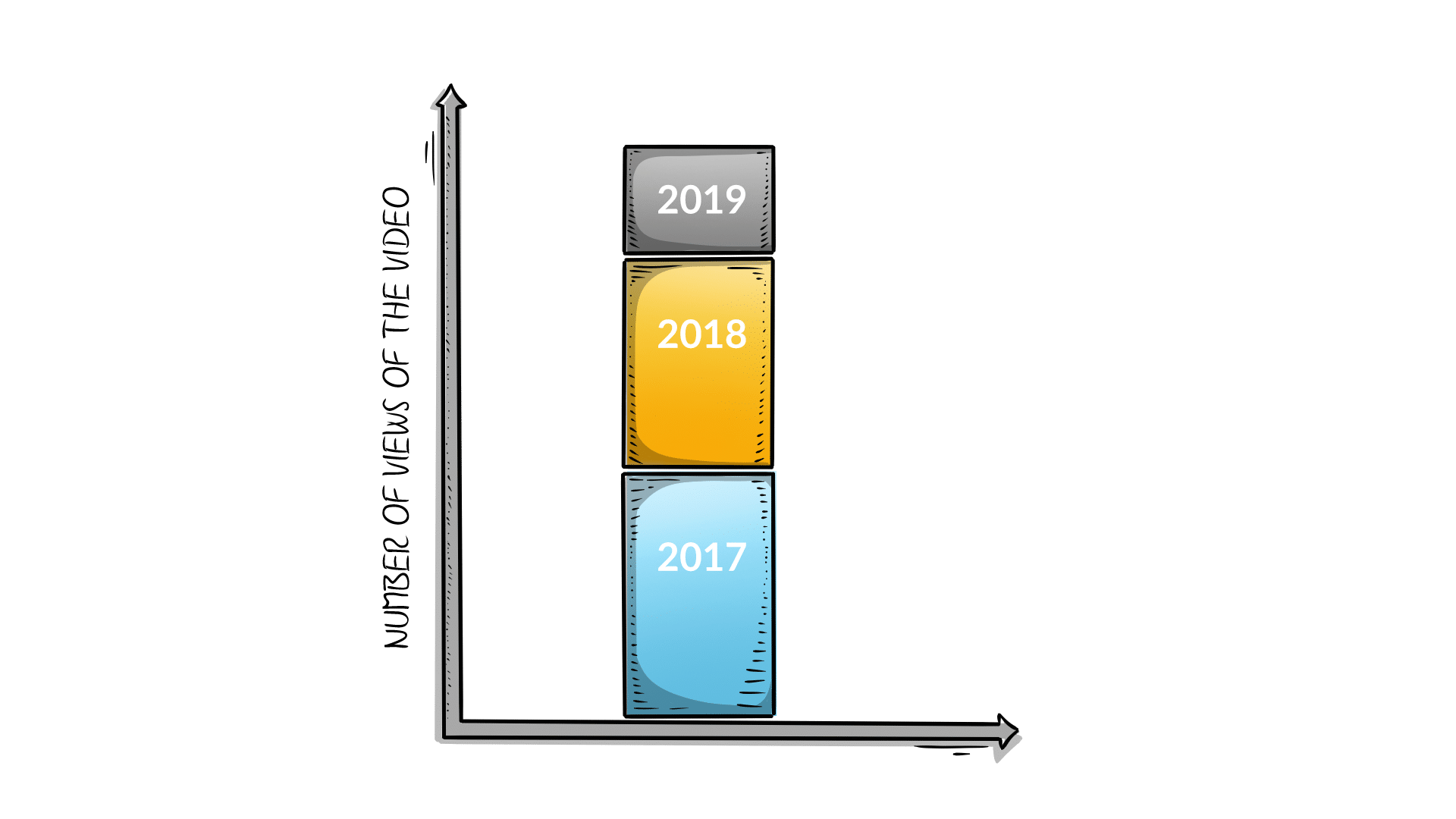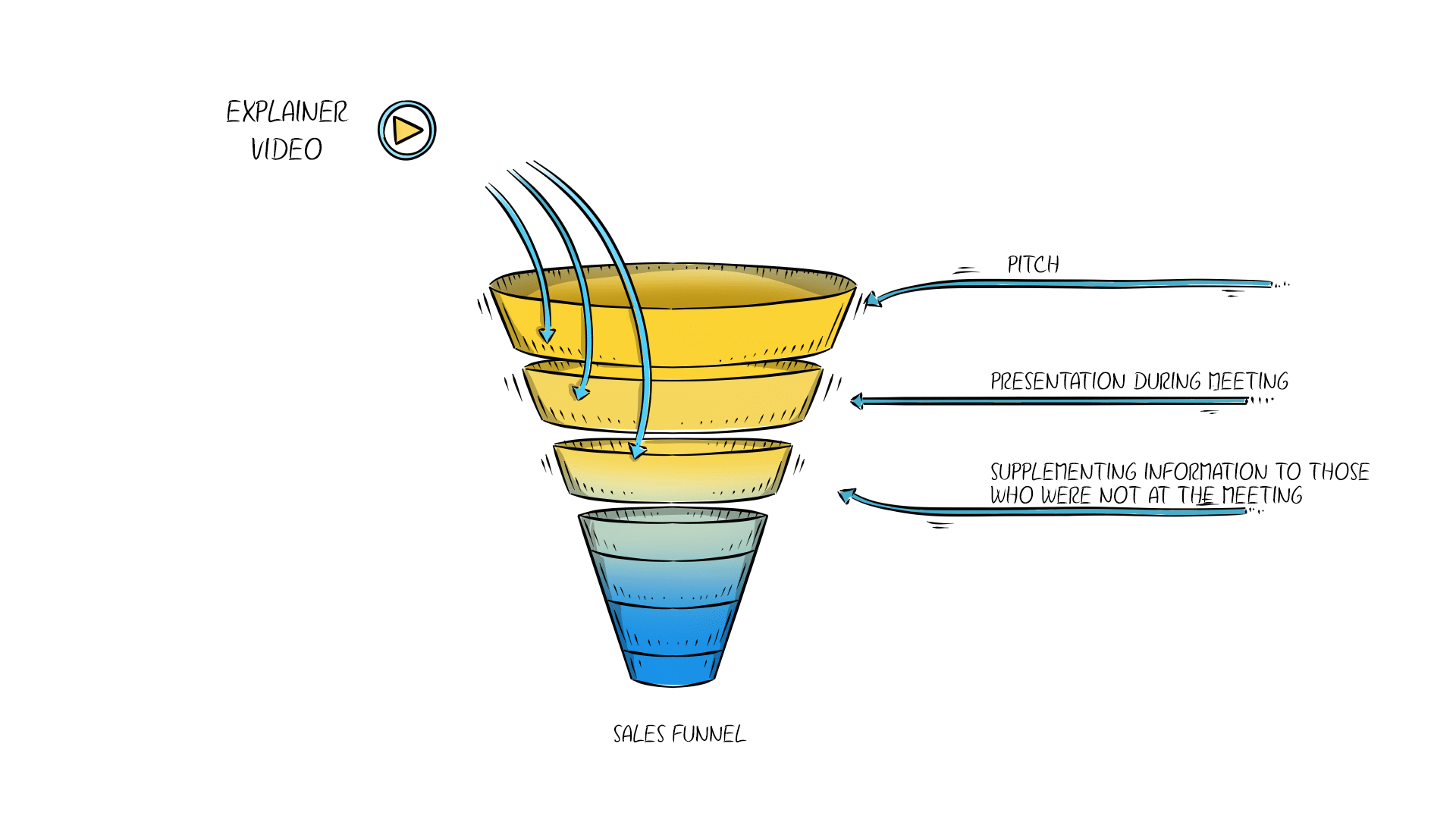As we wrote earlier in the text about explainer video, the production of such an animation usually costs from 2 000 to 7 000 EUR.
How to calculate whether this expense will pay off? And how to estimate the explainer video’s possible results?
In this text, we will tell you, step by step:
1) What are the best results you can expect;
2) What indicators should be taken into account when calculating the profitability of production depending on whether it is for marketing, sales, or internal communication;
3) How to translate it into specific numbers.
And at the end of the article, we give you the possibility to download the ROI calculator in Excel. Thanks to it, you can easily estimate the return on investment for your company’s explainer video.
Examples of the highest profitability of an explainer video
Marketing and sales:
In this area, we have the most information on the ROI of an explainer video. However, it should be remembered that you still have to deduct the costs of marketing campaigns in some cases.
The most spectacular case is the explainer video of Dropbox. It cost several thousand dollars and helped attract (according to various estimates) about 150,000 users, translating into a $15 million revenue. However, this result is from “the best of the best” category. Dropbox’s product was also very viral itself, so it is hard to expect to replicate this kind of result.
In the startup sphere, we have, for example, the history of the Israeli Seegnature, where several thousand dollars were converted into a million dollars for first place in the contest for the best insurance startup in Israel. This gives an ROI of 22486%.
From the Polish backyard, an interesting case study is an animation for the platform “Więcej niż LEK” it helped the company earn its first 100 000 EUR. In this case, it has ROI of 4445%, although the campaign costs would still have to be deducted.
Implementation and training on procedures:
In this area, ROI will be based primarily on savings.
One of the world’s largest beverage companies used HSE animations instead of training. According to their information, this saved 50 hours/month in 20 factories in Europe. Thus, every month it was a saving of 1,000 man-hours and on an annual basis 12,000 man-hours.
Even assuming the rate of 8 EUR gross/hour (according to the Polish national average in 2019), we are talking about savings of 70-100 thousand EUR per year. More on this cooperation and its results: Review on Clutch from HSE Manager at Carlsberg.
Communication on strategic initiatives:
It is difficult to give specific figures in this area.
Few companies measure the level of understanding of their new strategy, which makes it difficult to show that an explainer video helps to improve it.
That’s why here it usually stops at soft indicators.
For example, when we did a series of animations about the new IKEA GBS strategy, employees from several offices told the board that they finally understood the “Big Picture” and that it would be easier for them to implement the strategy. The American company XPLANE, on the other hand, achieved an 87% understanding and support of its client’s strategy.
Although it is difficult to convert such a result into money, in the following text, we propose some indicators that will help to estimate the value of such material.
How to calculate ROI explainer video for marketing and sales?
Marketing:
Here we propose four main indicators.
1) Reach
Why:
If we’re doing a small campaign on a fanpage with 100 followers and most of them are our friends and family, the results may not be stunning.
But if we have up to 100,000 followers, everything changes.
That’s why both client’s organic reach (size of the fanpage, number of followers on LinkedIn, number of subscribers on YouTube) and paid reach, implemented by the campaign, are important.
Of course, it happens that the explainer video becomes a mini-viral, just like the AutoCAD WS explainer video, which reached over a million views. But because an explainer video is primarily informative material, it is better not to assume it will become viral.
What’s important, if we have a good animation, it’s possible that we’ll reach a higher range with the same budget. In the case of 3S Grupa PLAY (a Polish telecommunication company), for example, we were able to generate B2B leads 10X cheaper.

The results like 1400 shares make your hopes up, but they are rare.
2) Customer value
Why:
If we sell socks and our client is worth 10 EUR, we have to reach many of them for the video to pay off.
In the case of high-margin businesses in which the client is worth, e.g., 3 000 EUR, three clients are enough for the explainer’s investment to come out on top.
Here, of course, the question arises whether the clients deciding on such expenses watch the video at all. According to Forbes’ research in 2010, as many as 65% of the decision-makers visited the supplier’s website after watching his video. Over the past decade, people have been watching more videos than less, so we can assume that customers like video.
3) Conversion
Why:
If customers understand perfectly well why it’s worth buying our product and don’t keep up with orders, investing in an explainer video won’t necessarily make sense.
However, if we want to increase the conversion and manage to hit this rate by 3% (as Dropbox did, jumping from 30% to 33%), it is a concrete increase that translates into the number of leads generated and customers acquired.
And the strength of the explainer video lies in the fact that it makes the recipient better understand the product being sold. So, if the product really makes sense, your client is more likely to fill out a form, make an appointment and finally make a purchase.
4) Time horizon
Why:
If you use a video in a week-long campaign, it has very little time to pay back.
Explainer videos, on the other hand, are the so-called evergreen content. This means that they are not used for just one campaign but are used on a website or in the work of salespeople for many years.
Therefore, you need to consider how long you plan to use the material. Most often, our clients use animation for at least three years.
A good example is the previously mentioned “Więcej niż LEK,” which has been using the video for more than three years and has gained more than 35.000 views in its very narrow target group.

Animations are used and work for the company for several years. Thanks to that the number of views is accumulated.
Sales:
Here the indicators will have a few things in common with the marketing ones.
1) Average number of prospects
Why:
If our salesman talks to 10 potential clients per month, the scale of the video effect will be smaller than if they talk to 100.
In the case of an explainer video, you also need to include people who will get in touch with the salesman themselves after he publishes the video on LinkedIn.

Publishing an explainer video on LinkedIn can get a lot of responses and encourage customers to contact the salesman.
2) Conversion
Why:
If the product “sells itself” and the seller’s role is limited to placing orders, the explainer video may not be necessary.
But if on average, you want to make 10 prospects out of 100 people you call, when you raise this ratio to 20 prospects per 100 calls, you will usually get better results.
And here the explainer video can be useful because it will tell your potential clients about your product clearly, concisely, and effectively. This will not only make the customer more willing to make a purchase but will also disqualify those who have misunderstood our services – so that sellers do not waste time on customers who will not buy the product anyway.
And as LiveSpace’s report “Co się naprawdę liczy w sprzedaży B2B” shows, as much as 72% of B2B buyers believe that the presentations of the company’s offer could be shorter and more comprehensive.
Moreover, the explainer is used in the prospecting phase and the later stages of the funnel. First of all, it is used to supplement the knowledge about our offer to those who were not at the meeting.
An interesting example here is the case study of the Akademia Skuteczne Raporty.pl, which successfully used animation to convince HR departments to order training courses in advanced Excel functions.

In sales explainer videos are used primarily in the first stages of the funnel.
3) Customer value
Why:
It is similar to marketing – if we sell socks and our client is worth 10 EUR, we have to get to many of them to make the video pay off.
But if we have a few business customers worth 5, 10 or 20 thousand EUR, then with the first few customers we get, the investment pays off. And then each additionally acquired client means additional profit.
4) Number of salespeople
Why:
Suppose we have a single salesman who takes care of everything and handles an average of 50 prospects per month. In that case, the video effect can be good because it will relieve the salesman from explaining the same thing to new clients all over again.
But it will be even better if we have 10 such salesmen.
Each additional salesman is like a screen on which the video will be displayed. The more salesmen, the greater the reach to customers.
5) Time horizon
Why:
Here the reasons are the same as in marketing – the longer you use the material, the longer it befits your company.
Salespeople usually use explainer videos for 3-5 years. This means that your video will earn you money long after you forget you’ve paid for it.
How to calculate the ROI explainer video in e-learning and procedure communication
Here, we rely primarily on three indicators.
1) Number of employees
Why:
If we have several employees, we can give them the most important procedures ourselves. And if they have questions, they’ll ask.
But if you make these employees 2000, the cost of reaching them by traditional methods such as 1 on 1 talks, workshops or training will be very high.
So if you can spend the money once and remind thousands of people about the procedures using a video, it’s a clear saving for the company.
2) Number of mistakes made
Why:
Nobody makes instructional videos of making ordinary tea. Not without reason – it is difficult to make a mistake during this procedure.
It is much easier to make a mistake when you are serving a customer, operating a machine, or an IT system. And our mistake usually means that someone has to take their time to fix it, which costs money.
So if there are a lot of mistakes, then the reasonability of an explainer video increases.
3) Consequences of errors
Why:
Heating a fish in a company microwave can fill the kitchen with an unpleasant smell, but the business consequences are not too great.
On the other hand, mistakes in the area of customer service or sales can mean specific losses for the company.
Errors in the area of health and safety may stop production at the factory and translate into a huge loss of money, not to mention injuries to employees.
In the case of errors in the area of cybersecurity, financial and reputational losses can be even greater.
So if an explainer video can help you understand and apply these procedures, it actually translates into savings for the company.
That is why, among others, Bank Millennium decided to invest in such an educational campaign on customer service standards, and Norwegian Carlsberg educates employees on occupational health and safety.

The consequences of not following the procedures can be very severe for companies.
How to calculate ROI from an explainer video in internal communication
Here we also offer 3 indicators.
1) Number of employees
Why:
If a company has 30 employees, it probably doesn’t make sense to make a video about strategy.
Usually, in such companies, the flow of information is fast, you can talk to the CEO in the kitchen while making coffee, and everyone more or less knows where the company is going.
However, if the company employs 3,000 people, it means that it has many departments that do not have much contact with each other.
If a strategy is created, it means that not everyone will be able to ask for details. Therefore, we risk that employees will start playing Chinese whispers and turn the relevant details of the strategy. And as a consequence, they do not act accordingly to the Management Board’s thoughts.
However, if we manage to influence 3000 employees and they work up to 1% more productively, with so many people, the effects can be very noticeable.
2) How much does it cost to create a strategy
Why:
If the strategy was developed during an evening conversation between two board members (e.g. while drinking wine), the cost of its development would not be high.
Of course, the consequences of not implementing it may still be felt, but although we do not have the impression that “so much time has gone by, we have worked so hard, and the effect is weak.”
On the other hand, if four board members built the strategy in a few hours’ workshops, and they ordered a market research, the cost of developing such a strategy is high.
Since thousands of euros have already been invested, poor communication will simply be a waste of that money.
3) Expected financial benefits from the project/strategy implementation
Why:
If we are implementing a project that has little impact on the company’s finances, it is possible that it is not worth investing in additionally and ordering an explainer video.
While in the case of strategy, it is easy to estimate what results we expect, how to do it during softer projects like implementing feedback-style culture? One of the ways is to think about what such a project can influence.
In the case of feedback, it can be: fewer mistakes made (because employees know what they do right and wrong), less rotation and therefore recruitment costs (because the atmosphere in the company improves), or fewer conflicts slowing down work.
Of course, it is difficult to turn it into a specific number, but it is worth to try to estimate its impact on the company’s finances. Examples of ideas for approaching the topic can be found in Michael Heller’s text.
4) A chance the project/strategy may be misunderstood, which may result in worse implementation.
Why:
If your strategy is to sell more of the cheapest products, it will be easy to comprehend. A few PowerPoint slides are enough. Therefore, there is little chance of misunderstanding.
However, if the strategy is a mix of customer focus, digital transformation and organizational culture change, there is room for misunderstanding.
The second component is also important, i.e. whether a misunderstanding of the project/strategy results in worse implementation. According to some studies, 70% or even 95% of employees do not fully understand the company strategy.
But will the fact that a warehouse worker in Walmart does not understand the strategy significantly affect his company’s results? Not really. On the other hand, Walmart’s distribution manager should probably know and understand the strategy in order to be able to implement it wisely.
Therefore, in the case of complex strategies, the possibility to explain and illustrate plans with an explainer video can be very useful.

Do you want to estimate your ROI?
Click the button below to download a template in Excel, where you can put your numbers and count for yourself if such a service is worth it.
Not every explainer video guarantees ROI
Will an explainer video, which goes quickly through the subject (without resolving viewer’s doubts) and puts the whole message in an unattractive form, achieve similar results?
No.
That is why it is worth focusing on quality in production, especially since the difference between an average explainer video and a good one can amount to 2 000 – 7 000€. At the same time, the difference in business effects can amount to tens, and sometimes hundreds of thousands of euros.
Especially since an explainer video is usually used for years. Quality is remembered much longer than then price.
Our explainer videos:

He has studied psychology at the University of Warsaw, and business at Warsaw School of Economics, as well as at University of Cambridge Judge Business School. During his studies, he has researched how people think when they are overwhelmed by information.
It has inspired him to focus on communication that explains complex subjects in a simple way. In Explain Visually, he has lead projects for companies such as IKEA, Carlsberg, Pratt & Whitney, Orange, and Pfizer. Fan of rational, science-based approach, and building marketing and sales on robust fundamentals.
